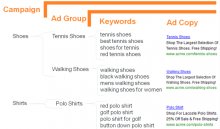 So you’ve decided to try out a pay-per-click (PPC) campaign for your business. Awesome! Paid search is an extremely powerful tool and a valuable asset for enhancing your company’s online presence. But let’s be honest here – Google AdWords can be a little intimidating when you’re just starting out. There are a handful of decisions to make when you’re setting up your campaign, and it’s not always clear how to approach them.
So you’ve decided to try out a pay-per-click (PPC) campaign for your business. Awesome! Paid search is an extremely powerful tool and a valuable asset for enhancing your company’s online presence. But let’s be honest here – Google AdWords can be a little intimidating when you’re just starting out. There are a handful of decisions to make when you’re setting up your campaign, and it’s not always clear how to approach them.
Let’s assume you’ve already compiled a list of relevant, long-tail keywords that you want to target. (If you haven’t, check out these keyword selection tools to help you out.) Once you've compiled your keyword list, you’re ready to create your AdWords account. Here are 3 important how-to’s for getting started.
1. How to Structure Your Account
 The structure of your account in Google AdWords is critical to the efficiency and success of your paid search campaign. So you have your keywords, you have the list of keywords that you're buying, and then you have the ad that you want to show when somebody types in one of those keywords. Now you want to group together the keywords for which you want your ad to be displayed, so that you can create highly relevant ad copy for these keywords and increase the likelihood that the searchers are going to click through.
The structure of your account in Google AdWords is critical to the efficiency and success of your paid search campaign. So you have your keywords, you have the list of keywords that you're buying, and then you have the ad that you want to show when somebody types in one of those keywords. Now you want to group together the keywords for which you want your ad to be displayed, so that you can create highly relevant ad copy for these keywords and increase the likelihood that the searchers are going to click through.
You can do this by creating a grouping of related keywords in what is called an “ad group.” So let’s say you have the keywords ‘tennis shoes, ’ ‘best tennis shoes, ’ and ‘shoes for tennis.’ You can create a ‘Tennis Shoes’ ad group, put those keywords in the ad group, and create an ad that is closely targeted to those keywords. Then if your company also sells other kinds of shoes, you can set up more ad groups, maybe for ‘Walking Shoes’ or ‘Running Shoes.’
 Let’s say your company also sells shirts though. Google lets you structure your account on one more level as well, and that is by “campaign.” So you can take all of your ad groups for shoes, put them in a ‘Shoes’ campaign, and then create another campaign for ‘Shirts’ with its own ad groups, keywords, and ads.
Let’s say your company also sells shirts though. Google lets you structure your account on one more level as well, and that is by “campaign.” So you can take all of your ad groups for shoes, put them in a ‘Shoes’ campaign, and then create another campaign for ‘Shirts’ with its own ad groups, keywords, and ads.
It's important that you structure your account in such a way that your keywords and your ad copy are tightly woven together. Then you can use your ad groups and your campaigns to keep them nicely bucketed together and better organized.
2. How to Set Your Budget
When you pay Google for your PPC campaign, you don’t whip out your credit card every time someone clicks on your ad. Instead, you set a daily budget on the campaign level. So for each campaign, you can dictate how much money Google can spend on those ad placements per day. For example, you can say you want to spend $300/day on your shoe campaign and $200/day on your shirt campaign, and Google won’t exceed those amounts.
But what if all that money is spent in only an hour or two? After all, if you have highly relevant or very popular keywords, you do run the risk of blowing through your budget quickly. Well, Google also offers a feature that allows you to request that your budget be spread out throughout the entire day. This works well for brands that want to establish a presence throughout the day.









